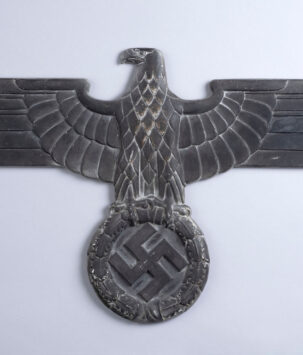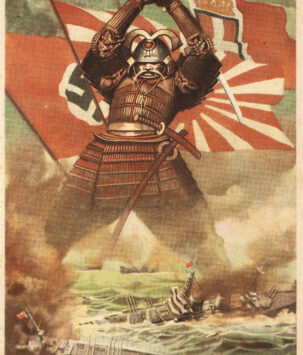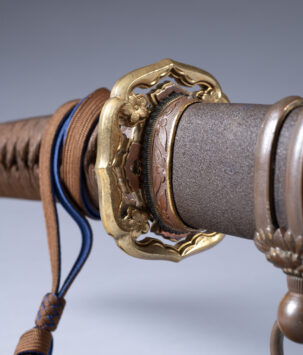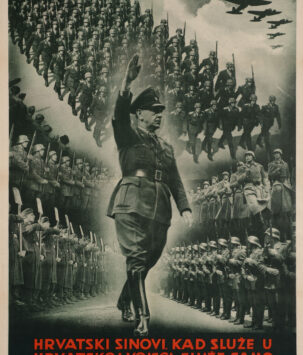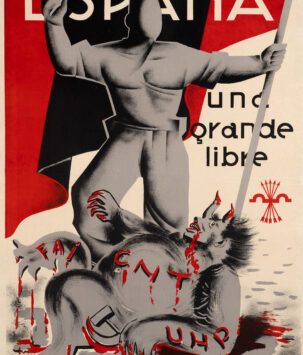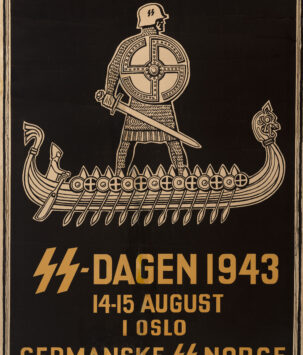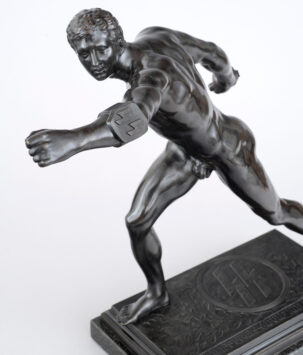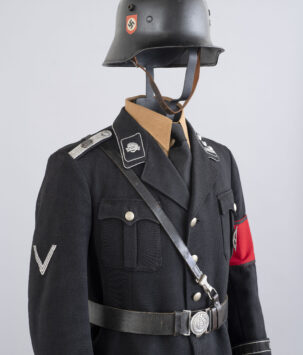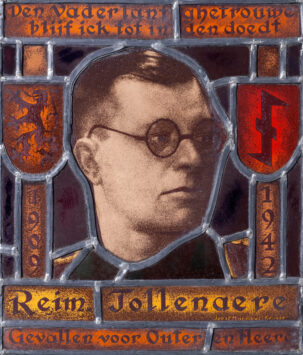Showing 61–72 of 94 results
-
An illustration of a cohort of German athletes participating in the Reich Sports Week. The Nazi regime placed great emphasis on the physical fitness of its people, and sports was seen as a means to harden spirits of its people and make them feel they were part of a wider national purpose.
-
A large, imposing, period bronze eagle set on a marble base embossed with the slogan “Ein Volk! Ein Reich! Ein Führer!” (One People! One Empire! One Leader!) referring to the spiritual unity of Germany through blood, soil and the Führer.
-
Eagle pulled off a locomotive of the Deutsche Reichsbahn, Nazi Germany’s state-owned railway enterprise. Originally in silver aluminum, these eagles began being coated in matte-black towards the end of the war as anti-aerial camouflage as German air superiority waned. The resulting appearance is a rather menacing and ominous one compared to its early-war silver counterpart. This aesthetic transition is reflective of the regime’s inward repression that only heightened as the war situation continued to deteriorate.
-
Postcard commemorating successive Japanese victories in the Pacific. The Imperial Japanese Navy is personified here as a mighty samurai. The subsequent fall of British Malaya and Singapore to the Japanese was described as “the worst disaster and largest capitulation in British history” by Prime Minister Winston Churchill, and this poster aims to highlight the supremacy and solidarity of the fascist triumvirate as they continued to enjoy victory on all fronts throughout 1941 and 1942.
-
Japanese soldiers during the Second World War garnered a reputation for their ferocity and unrelenting spirit in the face of countless unfavorable engagements. This was undoubtedly due to Japan’s stoic military culture. The Imperial Japanese Army (IJA), despite being a modern military force, was built on the feudal concept of Bushido, the moral code of the ancient samurai in which honor surmounted all else. In order to instill this warrior spirit in their soldiers and cement their ancestral link to the fearsome warriors of yore, the Japanese High Command endowed upon all their officers a traditional Japanese katana.
-
Army recruitment poster from the Independent State of Croatia. The leader Ante Pavelić can be seen at the forefront saluting his fascist legions with an address to the nation.
-
Spanish poster depicting a triumphant Falangist soldier standing atop a bloodied Marxist beast. The Falange Española (Spanish Phalanx) is a fascist political organization founded by José Antonio Primo de Rivera, taking its name from the heavy infantry formations of ancient Greece. It promoted the revival of the Spanish Empire, called for a national syndicalist economy and partook in the Spanish Civil War.
-
Poster issued by the Germanic SS of Norway depicting a soldier of the SS clad in chainmail atop a Viking longship. Typical fascist imagery drawing elements from the past which are incorporated into contemporary narratives about the historical continuity of a modern people’s existence.
-
The Schutzstaffel (SS) was the Third Reich’s preeminent elite paramilitary organization, driven by its fanatical devotion to National Socialism underpinned by a nexus of esoteric, occult and mystical principles. This grouping consists of a black M34 helmet, chained dagger and autographed portrait of Reichsfuhrer-SS Heinrich Himmler, all laid upon the backdrop of a period SS banner.
-
Patinated bronze sculpture of a figure with a Schutzstaffel vambrace and swastika baton. Inscribed ‘SS-Kampfpreis-Adolf Hitler-1939‘.
-
Early model black uniform of the 1. SS-Totenkopfstandarte “Oberbayern”, the elite progenitors of Germany’s infamous concentration camp system.
-
Finely crafted stained glass dedication of the Flemish nationalist paramilitary leader and Waffen-SS martyr Reimond Tollenaere.


